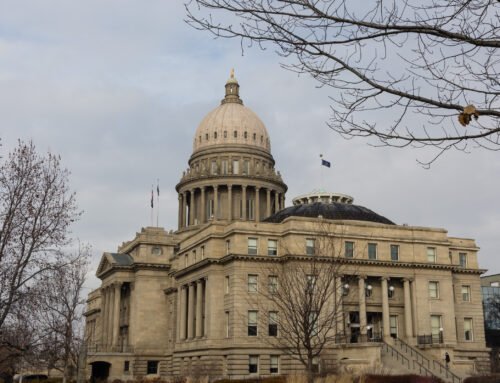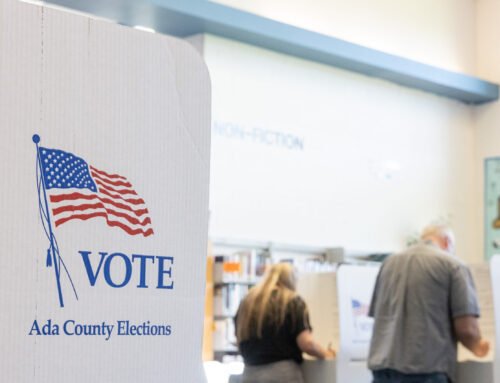Idaho school trustees wrapped up their business in Boise on Friday by approving seven proposed policy positions for lawmakers to consider in the 2024 legislative session.
Friday morning’s session marked the final day of the Idaho School Boards Association’s (ISBA) annual convention that draws more than 500 statewide school leaders. There were seven resolutions on the docket, all of which carried “do-pass” recommendations from the ISBA’s executive board. Here are the summaries of those resolutions and the margins of victory.
Aligning Idaho’s school age and public school accountability requirements
The resolution is sponsored by the Caldwell School District. It requests a change to the “required school age” in Idaho code from 16 to 18, unless the student has graduated early or has received a GED. Districts cannot ensure that students who drop out at age 16 meet necessary education requirements. There was no debate.
Yes: 6,045 No: 1,500
K-12 funding formula principles
The resolution is sponsored by the Boise School District. It requests the ISBA to work with the Legislature to adopt a funding formula that considers nine principles. These guiding principles represent a philosophical direction for funding public schools: budget predictability; adequately provide sufficient funding; fiscal transparency; annual budget stability; uniform and thorough support; funds quality staffing; ensure that no district loses funding; maintain enrollment-based funding; accountability that’s tied to each district’s goals.
Yes: 7,401 No: 171
Open enrollment program and building capacity limits
The resolution is sponsored by the Boise School District. This resolution seeks to manage the open enrollment process enacted this year because it needs more clarity. Idaho students can attend any school in the state, regardless of their address. There was some debate about how this will affect special needs programs. The resolution opposes a capacity exception tied only to grade-level enrollment. It requests modifying code to allow districts to make open enrollment decisions based on current allowed enrollment exceptions, and include both building capacity and special education capacity in those exceptions.
Yes: 6,191 No: 944

Requirements for paraprofessional employment in Idaho
This resolution seeks to reduce barriers for the recruitment of paraprofessionals. The current PRAXIS requirement is one of the main barriers. Local districts are no longer able to administer the test. The resolution asks that districts and charters be allowed to use a Board of Education approved local assessment or use an existing Board of Education approved subject matter competency test.
Yes: 7,618 No: 0
Career ladder placement for school nurse and speech/language personnel
The intent of the resolution is to develop a system for paying school nurse and speech/language personnel a salary that is commensurate with their professional and/or in-school experiences and to assist school districts in the recruitment and retention of such professional staff. There was no debate.
Yes: 7,479 No: 109
Streamlining consistent ISBA legislative priorities
ISBA members have priorities that may never be fully accomplished and others may take more time to accomplish. Instead of asking each resolution to be renewed, this streamlines the process and provides an avenue for other consistent priorities to be included in one resolution. Those priorities include: school boards retain strong governance and decision-making authority; consider more accurate, adequate, efficient and reliable options for funding school facilities; oppose tax dollars being allocated to private or parochial schools; oppose legislation that creates more undue burden on public schools. There was no debate.
Yes: 6,833 No: 744
Bond and levy election communications
The resolution’s sponsor is Bonneville Joint School District. It directs the ISBA to work with the Legislature to amend existing statute to allow school districts and other taxing districts more flexibility in communicating brief messages and reminders about public elections. The current statute makes it difficult to pass bond levies because a simple text to parents like “remember to vote” could invalidate an entire election. Communication to 20 or more patrons must include the same language contained on the election ballot, which adds anywhere from 50 to 200 words. The resolution seeks to clarify the law so it correctly reflects the intent of the Legislature. There was limited debate and it was all supportive of the measure.
Yes: 7,493 No: 99

The ISBA membership voted to elect two new executive committee members. The new president-elect is Brian Pyper of Madison School District. Pyper is a professor of physics with BYU-Idaho in Rexburg and a father of four. The outgoing president-elect is Starr Olsen. The new vice president is Jason Sevy, a dairy quality specialist, who serves on the Marsing School District board. The outgoing vice president is Brian Pyper.
Trustees from across the state meet each year for training, expert presentations and to vote on a legislative platform driven by proposals from local leaders.






Leave A Comment